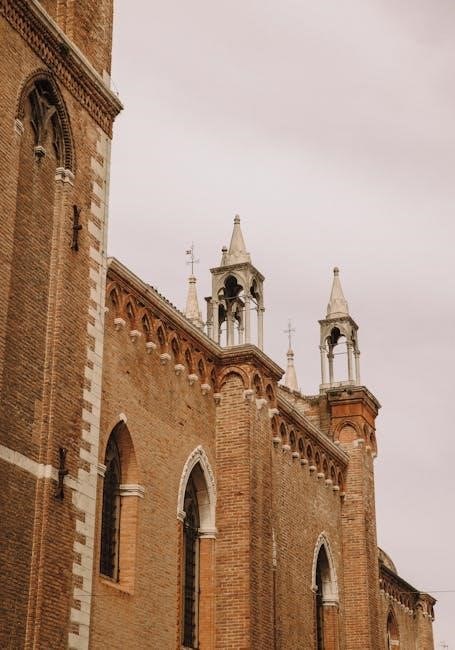The 24 Italian Songs and Arias collection is a timeless anthology of Baroque and Classical vocal music, featuring works by composers like Bononcini, Caccini, and Caldara. Available in PDF, it remains a cornerstone for vocal studies and performance, offering rich historical context and artistic expression.

1.1 Historical Significance
The collection of 24 Italian Songs and Arias holds a profound historical significance, representing a cornerstone of vocal music from the 17th and 18th centuries. These works, composed by masters like Bononcini, Caccini, and Caldara, encapsulate the evolution of Italian vocal music, bridging the Renaissance and Classical periods. The arias reflect the bel canto tradition, emphasizing expressive melodies and lyrical phrasing. This anthology has served as a foundational resource for vocal pedagogy for over a century, shaping the technique and interpretation of singers worldwide. Its enduring popularity lies in its ability to connect modern performers with the rich musical heritage of Italy’s Baroque and early Classical eras. The PDF editions available today ensure that this historical treasure remains accessible, preserving the authenticity and artistic value of these timeless pieces for future generations of musicians and music enthusiasts alike.

Composers and Their Contributions
The 24 Italian Songs and Arias feature works by renowned composers such as Bononcini, Caccini, and Caldara, showcasing their mastery of Baroque and early Classical vocal music. Their compositions exemplify bel canto technique, blending lyricism and dramatic expression.
2.1 Notable Composers: Bononcini, Caccini, and Caldara
Bononcini, Caccini, and Caldara are central figures in the 24 Italian Songs and Arias collection, each contributing iconic works that define Baroque vocal music. Bononcini, known for his operatic arias, offers the dramatic “Per la gloria d’adorarvi” from Griselda, showcasing his mastery of melodic expression. Caccini, a pioneer of monody, is represented by the hauntingly beautiful “Amarilli, mia bella,” a piece that highlights his ability to blend simplicity with emotional depth. Meanwhile, Caldara’s “Alma del core” stands out for its lyrical warmth and technical demands, reflecting his skill in crafting arias that balance intimacy and grandeur. These composers not only shaped the Baroque era but also left a lasting legacy in vocal repertoire, making their works essential for singers and scholars alike. Their contributions to the collection underscore the artistic and historical richness of Italian vocal music during this period.

Structure of the Collection
The collection features 24 songs and arias from the 17th and 18th centuries, organized to showcase the evolution of Italian vocal music. Each piece is attributed to its composer, spanning works by Bononcini, Caccini, Caldara, and others, offering a diverse range of styles and periods.
3.1 Breakdown of Songs and Arias
The collection is divided into 24 distinct songs and arias, each showcasing the artistic brilliance of Italian composers from the 17th and 18th centuries. The pieces are attributed to renowned composers such as Bononcini, Caccini, and Caldara, with works like Per la gloria d’adorarvi, Amarilli, mia bella, and Alma del core. These compositions represent a variety of vocal styles, from expressive arias to lyrical songs, highlighting the emotional depth and technical demands of Baroque and Classical-era music.
The selection is carefully curated to provide a balanced mix of well-known and lesser-known pieces, offering singers a comprehensive repertoire for study and performance. Each song is accompanied by detailed historical context, enabling performers to interpret the works with authenticity and nuance. The PDF edition further enhances accessibility, featuring high-quality scans and clear notation, making it an invaluable resource for vocal students and professionals alike.

Benefits of the PDF Edition
The PDF edition of 24 Italian Songs and Arias offers unparalleled convenience, with high-quality scans and clear notation. It provides easy access to the entire collection, allowing singers to study and perform without the need for physical copies. Additionally, the digital format enables seamless navigation, making it an essential tool for modern vocalists.
4.1 Features of the Digital Edition
The digital edition of 24 Italian Songs and Arias offers a multitude of features that enhance both learning and performance. One of the standout aspects is the inclusion of high-quality piano accompaniments, expertly recorded to provide a professional backing for singers. This feature is particularly beneficial for students who may not have access to a live accompanist, allowing them to practice and perform with confidence. The PDF format ensures that the music is presented in crisp, clear notation, free from the wear and tear that can affect physical copies over time. Additionally, the digital version is fully searchable and easily navigable, making it simple to locate specific pieces quickly. For educators, the ability to share the PDF with students or print individual selections is a convenient advantage. Moreover, the digital edition often includes historical notes and performance tips, offering valuable context and guidance for singers seeking to interpret these classic works authentically. These features collectively make the digital edition an indispensable resource for vocalists, educators, and enthusiasts alike, ensuring that this beloved collection remains accessible and relevant in the modern era.

Educational Use
The 24 Italian Songs and Arias PDF is a foundational resource for vocal education, offering a diverse repertoire of Baroque and Classical pieces. It introduces students to Italian vocal music, aiding in the development of technique, expression, and historical interpretation, making it indispensable for young singers.
5.1 For Vocal Students
The 24 Italian Songs and Arias PDF is an essential resource for vocal students, providing a comprehensive collection of Baroque and Classical pieces. It includes works by renowned composers such as Bononcini, Caccini, and Caldara, offering a diverse repertoire for study and performance. The PDF format allows for easy access and portability, making it ideal for practice and rehearsal. Students can explore various vocal styles, from expressive arias to intricate songs, while developing their understanding of Italian vocal technique. The collection is particularly valuable for those seeking to master the nuances of 17th- and 18th-century music, with each piece offering insights into historical performance practices. Additionally, the inclusion of piano accompaniments in the digital edition enables students to practice with harmonic support, enhancing their ability to interpret and deliver these timeless works effectively. This anthology serves as a bridge between historical tradition and modern vocal training, ensuring its continued relevance in the education of aspiring singers.

Notable Pieces
The collection includes famous arias like Amarilli, mia bella by Caccini and Alma del core by Caldara. These works are celebrated for their lyrical beauty and technical demands, making them staples in classical vocal repertoire and a testament to Baroque musical craftsmanship.
6.1 Famous Arias Included
The collection boasts iconic arias such as Amarilli, mia bella by Giulio Caccini and Alma del core by Antonio Caldara, renowned for their expressive melodies and technical challenges. Per la gloria d’adorarvi by Giovanni Bononcini and Comerògiodisolio by Alessandro Scarlatti are also featured, showcasing the lyrical richness of the Baroque era.
These arias have been performed by legendary vocalists and remain essential repertoire for classical singers. Their inclusion in the 24 Italian Songs and Arias PDF underscores the collection’s historical and artistic significance, providing singers with a diverse range of stylistic and emotional expression.
The PDF edition enhances accessibility, allowing performers to study and interpret these masterpieces with clarity. Each aria offers a unique glimpse into the musical genius of its composer, making the collection a treasured resource for both learning and performance.
From the dramatic intensity of Sebben, crudele to the delicate charm of Vittoria, mio core!, these arias exemplify the elegance and passion of Italian Baroque music, ensuring their continued relevance in modern vocal training and repertoire.

Performance Tips
Mastering the 24 Italian Songs and Arias requires attention to historical context, expressive phrasing, and technical precision. Study dynamics, articulation, and breath control to bring these Baroque and Classical pieces to life with authenticity and emotional depth.
7.1 Interpretation and Technique
Interpreting the 24 Italian Songs and Arias demands a deep understanding of Baroque and Classical performance practices. Vocalists should focus on ornaments, trills, and dynamics as indicated by composers like Caccini and Bononcini. Proper breath control and nuanced phrasing are essential for conveying the emotional depth of each aria. pianist accompaniments, such as those recorded by John Keene, provide valuable support for singers. Attention to historical context and the use of period-appropriate techniques ensure authenticity. Additionally, understanding the Italian text and its poetic imagery is crucial for delivering a compelling performance. Practice should include thorough study of scores, attention to articulation, and careful balance between vocal agility and expressive lyricism. Mastery of these elements will enable singers to bring these timeless works to life with both technical precision and artistic sensitivity, making the 24 Italian Songs and Arias a cornerstone of vocal repertoire.

Modern Relevance
The 24 Italian Songs and Arias remain a cornerstone of vocal education and performance today. Their timeless appeal, coupled with the convenience of the PDF edition, ensures their continued relevance in modern musical studies and performances worldwide.
8.1 Continued Popularity and Performances
The 24 Italian Songs and Arias continue to captivate audiences and vocalists alike, with their timeless beauty and emotional depth. Performances of these pieces are frequent in recitals, competitions, and academic settings, showcasing their enduring relevance in classical music.
The collection’s popularity stems from its masterful blend of Baroque and Classical styles, offering a diverse repertoire that challenges and inspires vocalists. The availability of the PDF edition has further enhanced accessibility, allowing singers and educators to explore these works with ease.

Many renowned artists and students alike perform these arias, as they provide a foundation for understanding Italian vocal technique and expression. Their continued presence in modern performances highlights their lasting impact on vocal music tradition.
Whether in concerts or educational contexts, these songs and arias remain a vital part of classical music’s living heritage, ensuring their relevance for future generations of musicians and audiences alike.
